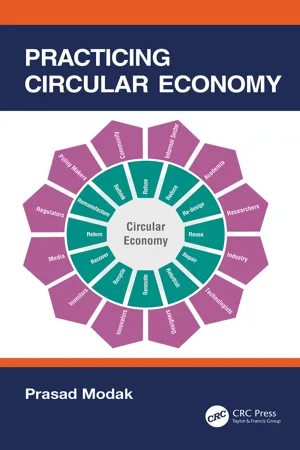
- 356 pages
- English
- ePUB (mobile friendly)
- Available on iOS & Android
Practicing Circular Economy
About This Book
Circular Economy (CE) is considered as one of the important strategies in addressing Sustainable Development Goals. Practicing Circular Economy provides an overview of CE, covering its evolution, describing the key concepts, programs, policies, and regulations. It illustrates several business opportunities over a hundred hand-picked case studies that encompass numerous sectors, various scales of operations and geographies. Another unique feature of the book is the activities listed in each chapter to invoke thoughts, frame assignments, and generate discussions. Each chapter lists key additional reading materials and takeaways.
Aimed at mid- and senior-level managers, policy makers, investors, entrepreneurs, consultants, researchers, professors, and academic students involved in the subject of environmental management and sustainability, this book:
-
- Introduces the evolution of CE to clarify the key concepts and introduce some of the important global programs and initiatives CE economy with case studies
-
- Gives a global overview of adoption of CE covering countries such as India, Japan, Korea, China, EU, North America, Australia, and several more
-
- Includes information on methodologies followed, tools, and knowledge resources for practicing CE
-
- Provides insight to the business models with numerous case studies covering product design, manufacturing, and services and the role of innovation and financing
-
- Presents a comprehensive overview of opportunities in CE in sectors such as textile, steel, agriculture, and food
-
- Covers newly emerging paradigms of CE such as regional circular economy, circular supply chains, and sustainable procurement and impact of the COVID-19 pandemic on CE
Practicing Circular Economy is thus an important resource for every circular economy practitioner and especially to those who aspire to make a career in circular economy.
Frequently asked questions
1
Challenges We Face Today
1.1 Rising Population and Urbanization

- The world population is projected to reach 8.5 billion in 2030 and increase further to 9.7 billion in 2050 and 11.2 billion by 2100.
- More than half of the global population growth between 2020 and 2050 is expected to occur in Africa.
- Around 2027, India is projected to overtake China as the world's most populous country, while China's population is projected to decrease by 31.4 million between 2019 and 2050.
1.2 Rising Consumption and Impact of Trade Flows
- To access the data, click on the dateline button at the top and slide the scale to the right and advance through the years. This will enable you to see how and where cities of 500,000+ inhabitants have grown since 1800, plus predictions for future growth up to 2030. A summary of the wider global changes taking place can be found at the top.
- By hovering the cursor over individual cities, precise data regarding those cities could be obtained. Alternatively, click on the “grid” view toward the visual's top right to see a chart of the individual cities and where they rank in terms of population.
- How the populations have changed over time, and the predictions until 2030, can be seen by sliding the scale to the right.
- The export of fruits and vegetables from Peru's dry desert coast increased tenfold from 2001 to 2015.
- During the same period, Ecuador tripled its flower export from the fragile drought-prone Andean hill slopes North of Quito and is now the third flower-exporting cou...
Table of contents
- Cover
- Half Title
- Title Page
- Copyright Page
- Contents
- List of Figures
- List of Tables
- List of Boxes
- List of Activities
- Preface
- Acknowledgement
- Author Biography
- List of Abbreviations
- 1. Challenges We Face Today
- 2. Key Concepts, Strategies, and Programs
- 3. Circular Economy Toolbox
- 4. 12 Rs of Circular Economy
- 5. Making Longer Lasting Products
- 6. Closing the Loop
- 7. Circular Economy in Select Sectors
- 8. Business Models in a Circular Economy
- 9. Innovation and Financing in Circular Economy
- 10. Governance in CE
- 11. More Insights and Way Forward
- Index